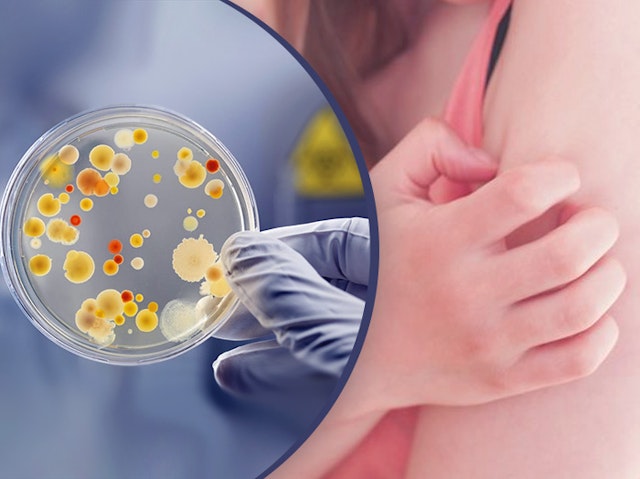Bacterial Therapy May Bring Hope for Eczema Sufferers

Bacteria Therapy For Eczema
Eczema, is a skin condition that affects approx. 28 million Americans of all ages. Itching, inflammation, painful skin lesions are few of the eczema symptoms that are generally observed in the patients. “Living with atopic dermatitis can be physically and emotionally challenging,” Anthony S. Fauci, director of the National Institute of Allergy and Infectious Diseases, said in a statement. “Currently available therapies can be time-consuming—requiring multiple daily applications—and costly.”
Healthcare industries can be seen targeting eczema patients with the expensive lotions, ointments, oils and other healthcare products. To save you from an expensive healthcare budget, scientists have identified a potentially effective and cheap alternative to treat the eczema by using bacteria therapy.
As per the new research, treatment with a naturally occurring good skin bacteria can prove to be effective in adults and children suffering from atopic dermatitis. Applying good bacteria to the skin may kill bad bacteria. When researchers look at the skin of an eczema patient, they have found a larger percentage of Staphylococcus aureus (unhealthy bacteria that is known to causes of eczema), immune imbalance, and a lower percentage of good bacteria on the skin. So, the researchers hypothesize that treating skin condition with the good bacteria can provide the desired results.
Exciting positive results can be seen in the initial studies.
Clinical trial at the National Institute of Allergy and Infectious Disease (NIAID) by the National Institutes of Health has shown positive results in its initial study. This study was conducted for six weeks, where 10 adults and 5 children applied a spray containing Roseomonas mucosa, naturally occurring bacterium twice a week. Six out of ten adults showed 75 percent improvement in the rashes, itching and four out of five children had same 75 percent improvement.
As per the study no one was reported with an adverse effect or any complication. Those whose condition remained the same had a strong family history of the skin diseases. Ten out of 15 people had a dramatic improvement with no problems,” said NIAID’s Ian Myles, MD, the principal investigator.
The NIH researchers chose R. mucosa to alter the skin’s microbiome, and these results seem to suggest that microbiome-targeting interventions show a real therapeutic potential. This is definitely not the first time that bacterias have shown promising results against the skin diseases,in fact, in a study published last february, few Staphylococcus strains inhibited the growth of S. aureus on the skin of an individual.
To understand in a better way, there may be few factors that contribute to bacterial imbalance in the skin. The investigations were conducted by the scientists to see if the chemicals produced by R.mucosa may be associated with eczema. They deduced that strains of R.mucosa from atopic dermatitis patients produced skin irritants while the strains withdrawn from the healthy skin yields chemicals that may enhance skin barrier and help regulate immune system.
Final results from an ongoing study at NIH will provide the foundation for larger trials to evaluate the efficacy of this investigational therapy, as well as to better understand the role of R. mucosa in atopic dermatitis
Myles, an NIAID researcher, said in an institute news release that “If future clinical studies demonstrate that this strategy is effective, we hope our work will lead to development of new, low-cost atopic dermatitis therapies that do not require daily application,”
3 Types of Phototherapy for Eczema (Atopic Dermatitis)
Ultraviolet B (UVB), ultraviolet A (UVA), or a combination of UVB and UVA may be used during therapy. According to Dr. Page, there are three different forms of eczema phototherapy “
1. Broadband UVA Eczema phototherapy
Phototherapy uses lightwaves to treat certain skin conditions. The skin is exposed to an ultraviolet (UV) light for a set amount of time. Phototherapy uses a man-made source of UV light. UV light also comes from the sun. When combined with a medication called psoralen, the procedure is known as psoralen UVA (PUVA).
UV light shuts down immune system cells in the skin. It can help in skin conditions that are caused by an overreaction of the immune system. Skin conditions that are treated with phototherapy include:
Psoriasis — a skin disorder that causes red, silvery, scaly patches on the skin
Eczema — an itchy, red skin condition, or dermatitis due to allergies
Mycosis fungoides — a type of lymphoma confined to the skin
Vitiligo — a skin disorder where normal skin pigment is lost due to destruction of pigment-producing cells by the immune system
2. Broadband UVB Phototherapy For Eczema
The most common type of phototherapy used to treat eczema is narrowband ultraviolet B (UVB) light. This uses a special machine to emit UVB light, which is the best part of natural sunlight for treating eczema.
Broadband UVB phototherapy, PUVA (Psoralen and UVA), and UVA1 are other forms of phototherapy that may be used in special circumstances to treat eczema.
3. Narrowband UVB Eczema phototherapy
As these eczema treatments may be given more safely, so narrowband UVB is more effective and surely requires shorter time period to treat your skin condition. Elizabeth Page, says “It is as effective as other types of eczema phototherapy and has fewer side effects because you don’t need to take a pill. Narrowband UVB uses a very small part of the UVB spectrum, which cuts down on exposure to UV radiation.”